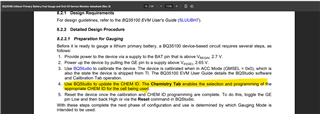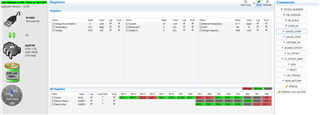Other Parts Discussed in Thread: BQSTUDIO
Tool/software:
Hi everyone,
I'm working with the BQ35100EVM-795 evaluation board, a CR123A primary battery, and a 23.5Ω resistive load to measure the State of Health (SOH) using bqStudio.
I've already:
-
Calibrated the gauge
-
Selected the correct battery chemistry (Duracell CR123A from the chemistry list)
I’m currently using the following procedure to initiate SOH measurement in SOH mode:
-
GE High (turn on the gauge)
-
Send GAUGE_START command
-
Wait for the [GA] bit to set
-
Apply the load
-
Send GAUGE_STOP command
-
GE Low (turn off the gauge)
However, I have a few questions and issues:
Questions:
-
GE pin control: To set GE high/low, should I physically remove/place the GE jumper on the EVM board? Or is there a recommended way to toggle GE from software (or externally)?
-
SOH measurement failure: Despite following the steps, I keep reading SOH = 100% in bqStudio. What could be the reason for this? Am I missing any prerequisites?
-
Why does the SOH value show 0% after the second time I initiate the SOH measurement using the procedure I described?
-
Impedance & R values: The measured Z and Scaled R values always show up as 0. What conditions must be met for these to be correctly updated?
What I’m looking for:
-
A clear, step-by-step guide using bqStudio and BQ35100EVM to correctly perform an SOH measurement for a primary battery.
-
Optionally, a firmware script or instruction sequence that can be loaded in bqStudio (like from the Data Memory or Command panel) to automate or verify the process. In other words, a code that I can use to correctly trigger GE with a relaxation time.
Any advice, documentation references, or example setups would be greatly appreciated. Thanks!






